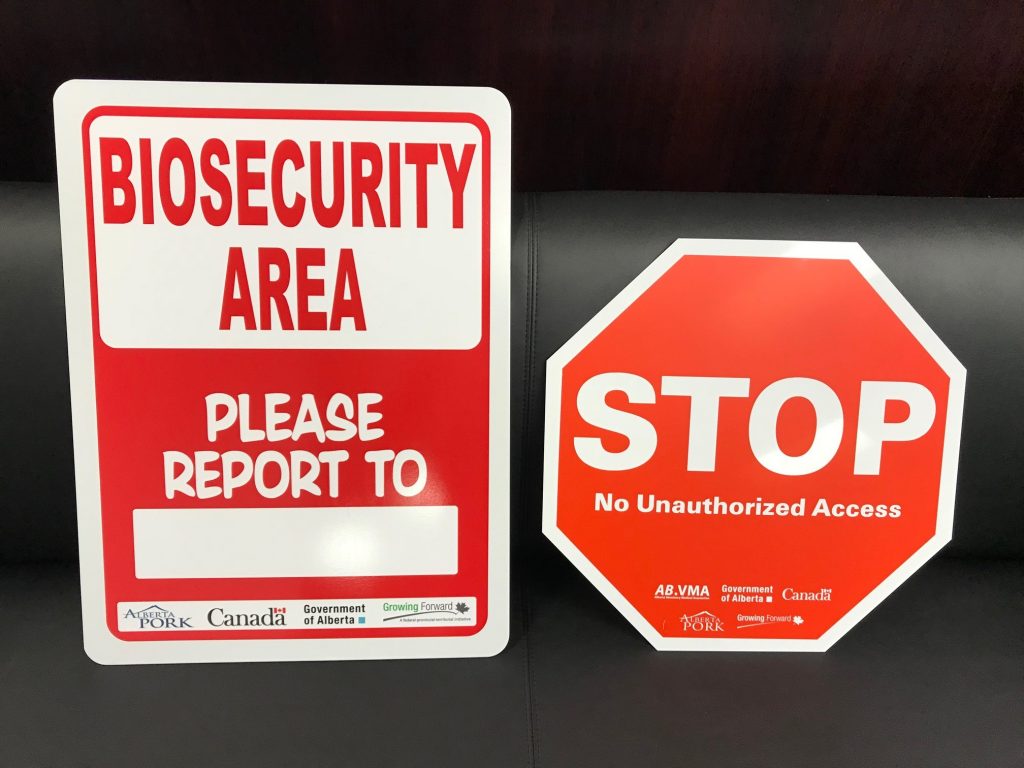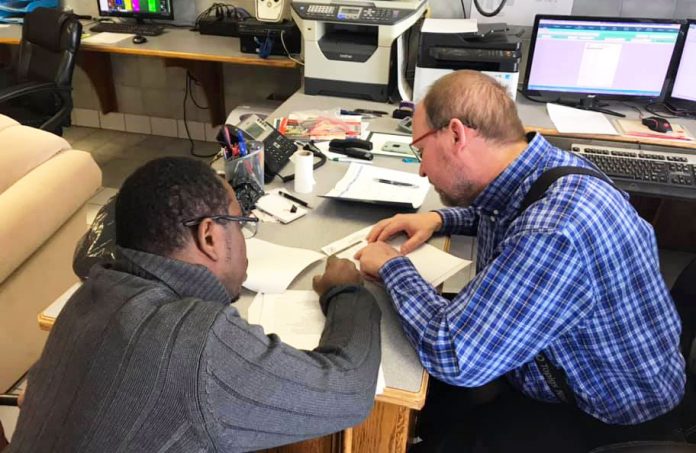By Andrew Heck

Effective biosecurity management is key component of a successful hog operation. Proper biosecurity protects both herds and humans from disease incursions that can affect animal welfare, staff health and business continuity.
Over time, the pork industry has been compelled to adapt biosecurity practices to fit the evolving reality of production, which means fewer but larger farms, workers travelling overseas, imported feed and equipment and other considerations that challenge the disease-free status of a farm.
Dr. John Harding, Professor, Western College of Veterinary Medicine, University of Saskatchewan, acknowledges that biosecurity remains the number one defence against disease: “We have a very complex animal health intensive livestock sector now involving multiple sites and large airspaces, with pigs being transported great distances,” he said in an interview with Farmscape. “We also have emergence of diseases or new viruses, new pathogens, emergence of antimicrobial resistance, potential zoonotic diseases – so there’s a lot of change that’s happened over the years.”
For producers, it is a constant battle to establish a biosecurity culture within a farm. Biosecurity is demanding, and most would sooner ignore it, if that was a reasonable choice. Ideally, biosecurity principles are backed by formal, written documentation, such as on-farm protocols. After that, discipline and conscientiousness must take over.
Standards demonstrate producer commitments

In January 2010, based on recommendations of the former Canadian Swine Health Board Biosecurity Advisory Committee, a first draft of the National Swine Farm-Level Biosecurity Standard was created. This voluntary standard is a tool for producers and industry stakeholders to tailor biosecurity measures to individual farm needs and provincial regulations.
The adaptable biosecurity standard addresses various planning considerations, direct and indirect routes of potential contamination and on-farm animal health. Underscoring these considerations are routine veterinarian check-ups, the use of medicines and many material costs including disposable gloves, masks and booties, plus disinfectants, degreasers and other products that are required for an effective program. All of these considerations come with a price tag, and those costs are often buried or overlooked, which is why further efforts are being made in some provinces and nationally to understand exactly what producers are paying when it comes to biosecurity.
The dilemma for producers is understanding and appreciating the importance of these practices while having little or no money to cover them. With that hit to producers’ pocketbooks constantly hammering away at already meagre farm incomes, it adds to the list of stresses that have producers reconsidering their hog operations altogether.
Every little bit adds up over time, creating a “death by a thousand cuts” scenario. When producers look across the table and see processors’ profits continuing to roll in, they are left wondering what value there is to their additional efforts.
Cleanliness does not come cheap

From one producer to the next, the realistic implementation of biosecurity protocols differs. Implementing biosecurity protocols extends beyond putting words to paper. Words require action, and action requires paying the running tab of costs associated with cleanliness. One of the most critical precautions and significant costs is truck washing.
In Alberta, nearly half of all pigs are self-hauled, while the other half are hauled commercially. In either situation, thorough cleaning is required after each load is delivered to the plant. The price to thoroughly wash and bake a livestock trailer commonly reaches into the hundreds of dollars.
Specifically, a proper truck-and-trailer cleaning job often costs no less than $1 per pig for a load of 200 pigs. This adds insult to injury after already having shipped a full load at a loss of several hundred dollars, with no direct financial incentive to reinforce the good behaviour. For many producers, the cost raises a series of questions: Do I wash with detergent, rinse with water, bake and disinfect? Or do I just wash and rinse? If no-one notices, can I get away with only rinsing?
Sadly, this process of rationalization is well-known. Experts agree, and most stakeholders in the value chain are aware, that enhanced biosecurity requires extra attention to detail and a concerted effort. But if the money is not there, is it surprising that any person in this situation might consider cutting corners? It is a dire prospect. In a world where several hundred dollars can put food on a family’s table for a matter of weeks, a truck wash might, unfortunately, not look like the best investment, even if it is critically important.
While all transport trucks are required to be clean before arriving on-farm, for a very small minority of producers who self-haul pigs, on-farm wash bays are an enhanced biosecurity feature used before the truck leaves the farm, which helps further eliminate potential biosecurity gaps. What does not change, no matter the producer, is that making use of appropriate post-delivery truck washing services means paying for the service each and every time he ships pigs, usually weekly… unless he decides not to, due to the prohibitive cost. That decision fundamentally challenges the quality assurance guarantees that processors rely on to influence consumers’ perceptions of food safety further down the line, which demands the implementation of additional best practices at the processing and retail levels.
Quality assurance depends on producer action
All commercial pork producers in Canada – those that sell their pigs to federally inspected slaughter facilities – are certified under the Canadian Quality Assurance (CQA) program or the new Canadian Pork Excellence (CPE) program. Quality assurance covers biosecurity at the farm and plant level, but these conditions inform mostly food safety, not farm management, in the strictest sense.
In 2019, the CPE program was launched with the intention of phasing out and modernizing CQA, which was first implemented in 1998. While CPE program adherence varies across Canada, the number of certified producers is steadily growing. In Alberta, objections to the cost of CPE have stalled the implementation of the program.
CPE includes 10 modules, including one for biosecurity. Under the biosecurity module, there are recommendations for feed and water, proper handling of live animals, pest control techniques, equipment maintenance and more. Program recommendations are consistent for all producers, but it is left up to producers to make choices that fit their individual operations. Almost universally, these choices are driven by financial impact. Whatever choices are made must be deemed acceptable by program validators, which is a measure of the program’s integrity. Individual producer choice does play a role in keeping costs down, but across the country, in most jurisdictions where pigs are raised, options are often limited.
Disease-free pigs translate into safe food

The challenge of maintaining strict biosecurity is compounded by the increasing costs producers must pay to meet quality assurance demands, which, for processors, are the basis on which their brands’ reputations are built.
For producers, the decision whether or not to embrace quality assurance places them between a rock and a hard place: pay for the program and sell to federal packers, or choose not to, and rely on other outlets such as provincially inspected plants or other marketing routes, which are few. Most often, this kind of decision would completely change the nature of an operation. For large-scale producers who raise the vast majority of hogs across the country, supplying our largest processors, it would be unconscionable.
A safe food system is paramount for Canadians and our international export partners. If food safety cannot be guaranteed, everyone in the value chain suffers. Food safety starts with proper biosecurity undertaken by producers and continues with further proper handling by processors and retailers. Food service establishments and consumers too have a role to play when preparing food in restaurant kitchens and at home.
While producers are more than willing to take seriously the demands of biosecurity, shrewd business considerations can undermine proper procedure, begging the question: if producers are not reasonably able to cover biosecurity costs, who will be left to produce the safe food that is generating record-setting revenues for some in the supply chain while taking every last penny from others? In the end, biosecurity on-farm and food safety in the plant, grocery store and at home are only as strong as the weakest link. For our part, as an industry, that means sharing the burden fairly.





